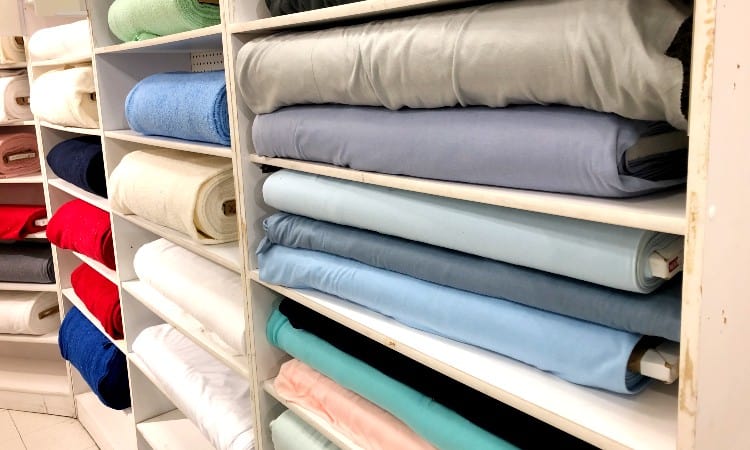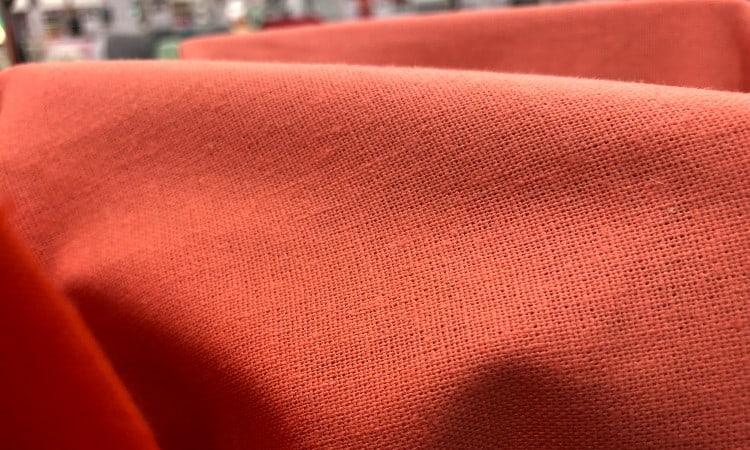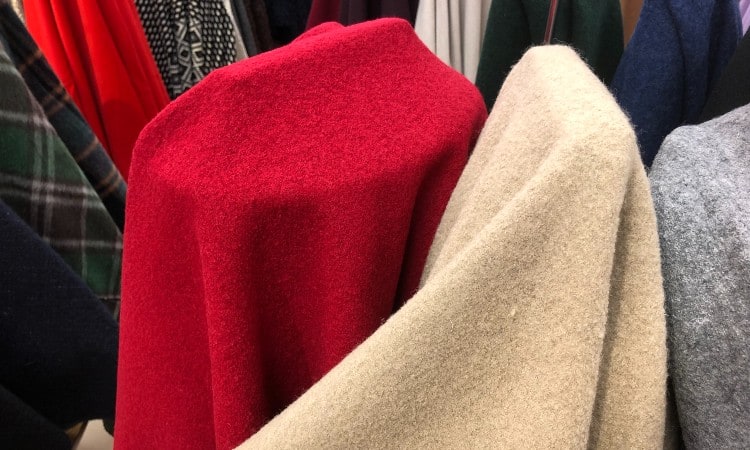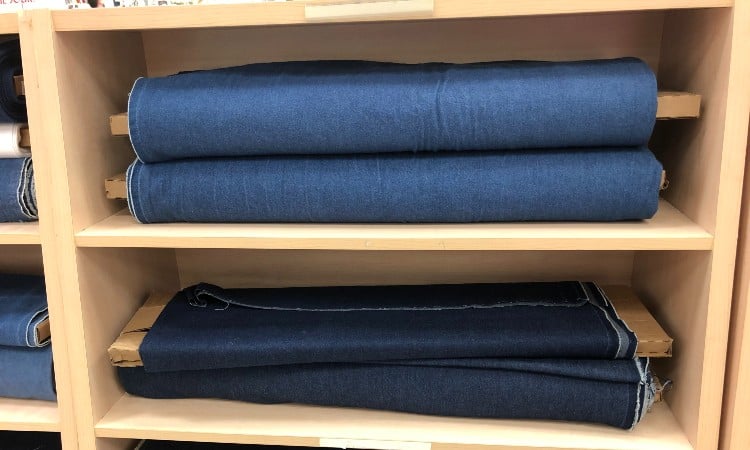Next time you find yourself shopping for bedding or towels, you may notice differences in the GSM between one brand and another. Understanding this unit of measurement for different types of fabric can help you buy the most comfortable blankets, sheets, and bath towels! So, what is the GSM of fabric?
The GSM of fabric stands for grams per square meter, a unit of measurement that describes the weight and density of a piece of material. This unit of measurement is commonly used on certain types of fabric like cotton. It is also used to describe fabric items like bedsheets, bath towels, and blankets.
In this article, you will find out what a GSM is and how to calculate it. You will learn what all the GSM numbers mean. Finally, you will discover how to use this measurement to find the best home goods and t-shirts the next time you go shopping!

Quick Navigation
What is the GSM of Fabric?
GSM in fabric stands for grams per square meter and means the weight of one square meter of material. Many manufacturers use this unit of measurement as quality control to make sure material does not contain significant holes or errors. GSM also tells the consumer how heavy or dense a piece of fabric is.
This metric measurement has become the international standard for most clothing and home goods manufacturers. Of course, in the United States, consumers do not have as much familiarity with the metric system. Just in case, a square meter equals about 10.7 square feet.
In some cases, especially in America, you may see oz per square yard, or oz/sq2, used instead of GSM. The basic idea is the same but this measures how much a square yard of fabric weighs and uses ounces instead of grams.
Using GSM, manufacturers and retailers can easily group anything made out of cloth into light-weight, medium-weight, or heavyweight categories. This gives you, as the consumer, a quick reference point for the thickness and quality of the material.
While there is some slight overlap depending on the kind of fabric, in general, fabric with a GSM of over 350 falls into the heavyweight category. This includes canvas, some kinds of brocades, most upholstery fabric, and most outdoor use fabric.
Medium-weight materials usually have a weight of between 150-350 GSM, a very wide range! This can include cloth like velvet, heavy satin, sateen, denim, and some jersey knits. Medium-weight materials often make excellent clothing because they can drape more than heavyweight fabrics.
Lightweight fabrics typically weigh between 30 to 150 GSM and may have some transparency. Types of material like silk, chiffon, most kinds of lace and mesh, and linen and some kinds of cotton, fall into this classification.
A heavier fabric will cost more than a lighter version of the same material most of the time. You can understand this because the heavier material contains a denser, thicker amount of thread that costs the manufacturer more! For example, thick, densely woven linen bedsheets usually cost more than lower quality, lighter-weight linen sheets.
Remember that GSM is not the same thing as a thread count. The thread count of a piece of fabric tells you how many vertical and horizontal threads fit within one square inch of the material. Grams per square meter describe the weight of the cloth, but thread count helps you understand the softness of the hand, or the feel, of the fabric.
GSM does not give you the same information as a fabric’s denier measurement. This unit of measurement tells you how thick the individual threads in the material are by comparing the threads to the size of a standard thread of silk.
Another thing to keep in mind is that GSM can’t tell you the characteristics of a material. For instance, silk with a high GSM could weigh the same amount as some types of canvas, but the silk will drape fluidly and the canvas will not!
So, how can GSM help you? Imagine shopping for a hoodie online. One hoodie uses fabric with a higher GSM than the other hoodie, though both garments contain cotton knit sweatshirt fleece. This tells you that the hoodie with a higher GSM uses a thicker, denser type of fleece, which will feel heavier as you wear it and keep you much warmer!
How to Calculate Fabric GSM

Professionals calculate fabric GSM by using a special swatch cutter that snips out circles in exactly 1/100th of a meter. This tool is often just called a GSM Cutter.
After selecting circles from various parts of the fabric, the manufacturer will weigh each 1/100th of a meter swatch and take the average of the measurements from all of the swatches. Finally, the manufacturer multiples that average weight by 100 and has an accurate cloth’s grams per square meter measurement!
If you do not have this special kind of swatch cutter, don’t worry! You can also use a different kind of at-home analysis to calculate the GSM. This does involve just a bit of math, though, so brace yourself!
- First, use a ruler to carefully cut out a square of your material measuring 10 cm by 10cm.
- Next, use a small scale set to grams to measure this square of cloth. Write down how many grams it weighs. This is the fabric weight for 100 square centimeters.
- Multiply this number by 100. This will give you the grams per square meter of the cloth!
- If you want to take things a step farther, you can test five different swatches and then use the average weight of all five squares to get the most accurate results.
However, keep in mind that most cloth, home goods, and clothing sellers will post GSM information in the product description online. In most cases, you will not have to determine the weight for yourself!
Which GSM Fabric is Good?

There is no perfect fabric GSM or easy way to determine which GSM of fabric is good or better than another because you will want different weights and thicknesses of material for different purposes.
Is a higher GSM better? Sometimes, yes! If you want warm winter clothing, a higher GSM often indicates a denser, thicker fabric that will offer more warmth.
But if you want a light linen shirt to wear in the summer, a lower GSM will tell you that the fabric has a lighter, more airy weave, which is preferable in that circumstance.
120 GSM Fabric
You can find several types of lightweight material in 120 GSM, including cotton greige, silky rayon, and even some very light cotton jerseys. For most types of material, a GSM of just 120 indicates a fine, light weave that may offer semi-transparency or, at the very least, an airy weave.
As a point of reference, even a 130 GSM t-shirt is considered lightweight, with 180 GSM as the standard for most cotton knit t-shirt materials.
Much of the fabric used for clothing such as blouses, dresses, or pants uses at least a 130 GSM. This offers a bit more of a structure to a garment, though it will still drape comfortably.
160 GSM Fabric
Fabric with a GSM of 160 falls just over the edge from a lightweight into medium-weight material. You can find lots of woven polyester at this weight, especially decorative types used for skirts and dresses. T-shirts with a fine, flexible cotton knit may use knits made with a 160 GSM.
Shirting fabric for men’s dress shirts and women’s blouses often falls into this weight range. Though softer and silkier materials may weigh less and stiffer, more structured materials can sometimes exceed 160 GSM.
Medium-weight linen bedsheets often have a GSM of 160, though thick, high-end sheets usually have a greater weight.
180 GSM Fabric
One of the most popular uses for fabric in a weight of 180 GSM is the standard cotton knit t-shirt. Of course, you can buy tees in various weights, but 180 GSM is the most popular. This jersey knit has a thickness you can feel between your fingers but still has the customary stretchiness and drape of any knitted material.
You often find quilting fabrics ranging from 150 to 200 GSM, with 180 GSM cotton a popular choice for a summer or fall quilt.
220 GSM Fabric
With a midweight GSM measurement like 220, you have moved out of shirting material and into fabric suitable for suits or luxury bedding. Cotton suits often use fabric with a GSM of 220 or 230.
Lots of drapery material will have this kind of midweight GSM measurement, as thicker, denser drapes can block out sunlight and hang more artistically.
300 GSM Fabric
Fabric with a weight of 300 GSM has a pretty hefty feel. Lots of hoodies use fabric with a GSM of between 300 to 400. Drapery and blankets may also use a GSM of 300 or slightly higher.
Also, most wool suiting materials will range in weight from 300 GSM to around 350 GSM. You can think of these as winter fabrics or heavier fabrics.
Fabric GSM Chart
For a quick overview of the average GSM for many popular types of fabric, check out this fabric GSM chart!
| Fabric Type | Average GSM |
| Cheesecloth | 40 |
| Muslin | 70 to 100 |
| Chiffon | 75 to 125 |
| Quilting Cotton | 140+ |
| Rayon | 140 to 160 |
| Percale Cotton | 200 to 400 |
| Cotton Jersey Knit | 100 to 200, 180 most common |
| Stretch Denim | 150 to 200 |
| Hoodie Fleece | 300-400 |
| Denim | 130 to 550 |
| Wool Suiting Fabric | 210 to 300 |
| Upholstery Fabric | 250-650 |
| Cotton Toweling | 300-900 |
What is GSM in Cotton Fabric?

The GSM of cotton fabric can vary widely, from 110 to 180 for most apparel cotton to 200 to 300 for cotton suiting fabrics and the heavier-weight grams per square meter of cotton material like denim.
Cotton is one of the most popular materials used for everything from clothing to bath towels, so you have to expect a lot of variation in the weight and density of these products!
The lightest, thinnest type of cotton commonly used is called muslin. This material typically has a weight of just 70 to 100 GSM.
Percale or plain-weave cotton used for bed sheets often has a GSM of 200 to 400. On the other hand, flannel sheets made from brushed cotton are probably good quality if they have a GSM over 170.
Cotton knits such as jersey knits often weigh more than plain-weave cotton because the knitted structure packs cotton yarns into a deeper layer than the basic over-under of a plain weave. Cotton knits also offer more stretch and softness than other kinds of cotton fabric. But cotton knits, like the fleece knit of hoodies or the stretch knit in t-shirts, can also come in many weights!
FOr t-shirts, the most common weight of the fabric is 180 GSM. Hoodies typically have a GSM over 300 because of the heavier fleece knit used for these garments.
You can find many kinds of heavyweight cottons, such as denim, canvas, and toweling which can range in weight from 300 upwards of 900!
How to Use Fabric GSM
One of the most useful reasons to understand GSM is that the measurement helps you buy the right sheets, towels, blankets, and clothes for every occasion. Knowing the average GSM for a product such as cotton bed sheets can help you seek out good-quality sheets instead of settling for thin, flimsy bedding!
Sheets
You can easily find information about the GSM of most types of bed sheet material like cotton, microfiber, polyester, or linen. Most companies place this information in the product description and thread count in some cases.
So, what is a good GSM for bed sheets? This depends on the kind of fabric in question.
Microfiber sheets contain incredibly fine threads, which create a soft, thin material. Because the material uses such fine threads, this material does not weigh a lot. Any GSM over 100 will give you durable microfiber sheets that should last a long time, but sheets with a 90 GSM or lower get flimsier and do not have such good quality.
For cotton sheets, you should start by looking at the thread count. A thread count of 400 or above is usually considered very good. Then you can consider the GSM to determine the weight and thickness of the cotton, though most manufacturers state that anything over 100 GSM should offer durability for long use.
Flannel sheets in a heavier weight offer more warmth, so keep an eye out for sheets with a 170 GSM or higher for heavy, long-lasting winter warmth.
Linen sheets made from flax should have a GSM of at least 160. Linen does not often even include a thread count and simply states the GSM to indicate its thickness and durability.
Towels
Understanding the GSM of bath towel fabric helps you find towels with extra softness and absorbency. Of course, other factors, like the type of material used in the towel, can also impact this. For instance, cotton fivers offer more softness and absorbency than polyester fibers.
But one of the main things you need to look out for is a high GSM if you want luxurious towels!
Here is a quick guide to help you out:
- Thin, lightweight travel or gym towels typically have a GSM of just 300 to 400 GSM. TO give you an idea of how this feels, many fuzzy kitchen towels often have this meager GSM!
- Many popular brands of bath towels, like the kinds you would buy at Walmart, Target, or a department store, come in 400 to 600 GSM. These feel much thicker in your hand and get progressively more absorbent with the higher GSM.
- Finally, towels that have a GSM of 600-900 fall into the “luxury” or high-end type of towels, like towels made out of Turkish or Egyptian cotton. These heavyweight towels will feel super soft and will have the ultimate absorbency.
Blankets
Every different kind of blanket comes with its own recommended GSM for the most warmth, weight, and durability. This can vary a lot from one type of blanket to another. For example, polar fleece blankets use a light, fuzzy fleece material that doesn’t weigh as much as other types of cloth.
You should look for a weight of 300 GSM if you want a nice fleece blanket that will last a long time.
Cashmere blankets can range in weight from 215 GSM to upwards of 300, but wool blankets can range from light summer throws of just 200 GSM to super thick winter woolens with a GSM of 700!
With blankets, the equation is pretty simple. A higher GSM always means a denser, warmer blanket!
Clothing
In many cases, knowing the GSM of the fabric used to make your clothes can help you make crucial decisions like buying the right shirt for hot or cold weather or buying trousers that have that expensive, heavy texture instead of a cheap flimsy texture.
On top of this, fabric with a higher GSM offers more density and will last longer through more washes than fabric with a lower GSM. You may also want to consider the weight of the fabric to help you save money, so you do not have to replace your clothes as often!
Unfortunately, there is no perfect GSM for high-class clothing! Every type of clothing uses its own preferred type of fabric and can come in a range of GSM weights within that category.
- Lightweight, breathable wool suit material usually starts at about 210 GSM. But more traditional, heavier suiting often has a GSM of closer to 290 or 300 GSM.
- Button-down shirts usually range in weight from 100 to 200 GSM. This is a pretty wide range, and shirts with a GSM on the lower range could just feature lightweight, summery material. Or they may offer less quality than the shirts with a higher GSM!
- The most commonly used weight for t-shirt material is 180 GSM. That said, a lower GSM does not necessarily mean poor quality. It just means a softer and less durable jersey knit material. The 180 GSM cotton knit you find in many t-shirts does last a very long time because of its higher weight and density, though!
- Hoodies can come in various weights because so many different hoodie styles remain popular today. Most of these have a GSM that falls between 300 to 400 GSM, though. A hoodie made out of hoodie fleece weighing 360 GSM will have a heavy, warm feel.
Conclusion
The GSM of fabric describes its weight and density using the metric system of measurement. It tells you exactly how much a square meter of the material weighs in grams. In general, fabric with a higher GSM will feel heavier and denser than fabric with a lower GSM and will often provide more warmth, durability, and even absorbency!
Knowing the standard GSM for household items like sheets and towels can help you find better products that last longer and hold up in the wash. Likewise, knowing what GSM to look for in clothing such as t-shirts and hoodies can help you buy products best suited to warm or cold weather.
Have you ever looked up the GSM of the fabric used in curtains, sheets, or towels before? Did knowing the weight of the fabric help you make a good selection? Leave a comment below to let us know!